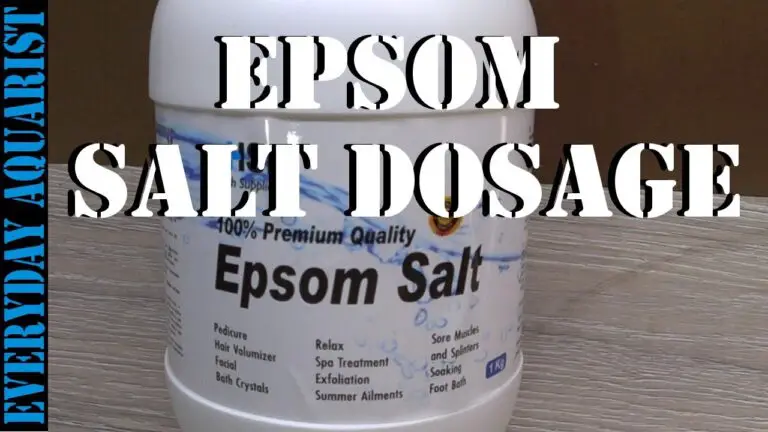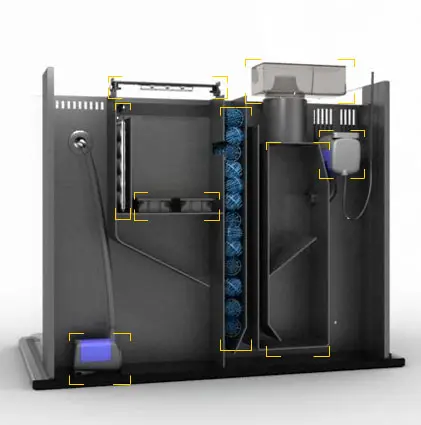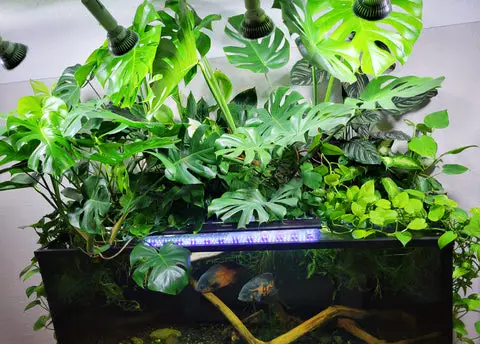Epsom Salt for Aquarium Plants: Essential Guide
Epsom salt is a mineral that can be added to aquariums for the benefit of aquatic plants. It contains magnesium sulfate, which helps to provide essential nutrients for healthy plant growth and provides an additional source of sulfur. Adding Epsom salt to your aquarium also helps increase oxygen levels in the water, which is beneficial for both fish and plants.
The recommended amount of Epsom salt to add varies depending on the size and type of tank but it should generally not exceed one tablespoon per five gallons (19 liters)of water. When adding Epsom salt, it’s important to monitor pH levels closely as using too much could result in an imbalance. In addition, regular partial water changes are necessary when using this product as prolonged use may cause nutrient imbalances over time.
Epsom salt can be a great way to naturally fertilize aquarium plants. It contains magnesium, which helps to promote healthy root and stem growth for aquatic plants. Plus, Epsom salt also aids in nutrient uptake and helps keep the water pH balanced.
By adding small amounts of Epsom salt to your aquarium’s water every few weeks you can help ensure that your aquatic plants stay strong and vibrant!
Epsom Salt Aquarium Dosage
Epsom salt is a great way to supplement the trace minerals found in your aquarium’s water. The recommended dosage for an aquarium is 1 teaspoon per 10 gallons of tank volume added every 2 weeks. To ensure accurate dosing, use an electronic scale to measure the salt and dissolve it in one gallon of tank water before adding it slowly into the main tank.
What Kind of Epsom Salt for Fish
Epsom salt is a mineral compound with many beneficial uses for fish, including treating various ailments. The best kind of Epsom salt to use for fish is food grade Epsom salt, as it has been refined and is free from additives or other chemicals that could be harmful to the fish. When using Epsom salt for your fish’s health needs, always follow dosage instructions carefully and monitor the water quality closely to ensure the safety of your aquatic pets.
Will Epsom Salt Kill Aquarium Plants
No, Epsom salt will not kill aquarium plants. In fact, it can be beneficial to them if used in moderation. Epsom salt provides the essential nutrients needed for healthy aquatic plant growth and contains sulfur which is important for photosynthesis.
However, too much can cause nutrient imbalances that are detrimental to your plants so always use it sparingly when introducing it into your tank.
How to Use Epsom Salt for Fish
Using Epsom salt for fish is a great way to improve water quality and provide valuable minerals. This natural product can be used as an additive in aquariums or ponds, providing essential magnesium sulfate which helps regulate pH levels, promote healthy skin and fins in the aquatic environment. Adding one tablespoon of Epsom salt per 5 gallons of water will help create the optimal environment for your fish to thrive.
Be sure to mix it into the tank slowly over time so that your fish don’t get overwhelmed by any sudden changes!
Is Epsom Salt the Same As Aquarium Salt
No, Epsom salt and aquarium salt are not the same. Epsom salt is a mineral compound made of magnesium and sulfate that has various health benefits when taken internally or used in topical treatments such as baths. Aquarium salt is a blend of sodium chloride (table salt) and other trace elements that can be beneficial to fish tanks by helping to maintain healthy water parameters.
Epsom Salt for Fish Parasites
Epsom salt can be used to help treat fish parasites by creating a salt bath. This involves adding two tablespoons of Epsom salt per gallon of aquarium water and allow the fish to soak in the solution for 15-20 minutes before returning them back into the tank. In addition, some aquarists also recommend using one teaspoon per gallon as part of their regular maintenance routine for preventing such infections from occurring in the first place.
Epsom Salt Or Aquarium Salt for Dropsy
When it comes to treating dropsy in aquarium fish, either Epsom salt or aquarium salt can be used. While Epsom salt is generally thought of as the better option due to its low sodium content and ability to draw excess fluids from a fish’s body, aquarium salt is sometimes preferred because it contains trace minerals that are beneficial for the health of fish. Ultimately, whichever type you choose should depend on what specific needs your sick fish has and how quickly you want them to recover.
Can Epsom Salt Kill Fish
No, Epsom salt cannot kill fish. While it is a common ingredient in many aquarium treatments, it has the opposite effect when used at higher concentrations. In fact, Epsom salt can actually be beneficial to fish as it helps maintain proper pH levels and electrolyte balance in their water environment.

Credit: www.amazon.in
How Do You Use Epsom Salt in an Aquarium?
Epsom salt is a popular choice for aquarium owners when it comes to treating their fish and tanks. It can be used in small amounts as part of a regular maintenance routine, or in larger doses to treat specific ailments. To use Epsom salt in an aquarium, begin by measuring out the correct amount according to your tank size.
Generally speaking, 1 tablespoon (15 ml) of Epsom salt per 10 gallons (37 L) of water should do the trick. Once you’ve measured out and dissolved the appropriate amount of Epsom Salt into your tank, let it sit for about 30 minutes before adding any new fish or other aquatic lifeforms back into the tank. This will allow time for the salts to properly mix with and dissolve in your aquarium’s water chemistry before introducing more stressors like fish waste or other pollutants that can throw off delicate balances within your system.
If you are using Epsom Salt to treat a particular condition such as Ich or Fin Rot, follow instructions on dosage carefully; usually higher concentrations are needed than those mentioned above—but always double-check with an expert if possible!
How Much Epsom Salt Do I Need for a Planted Aquarium?
When considering how much Epsom salt to add to a planted aquarium, it’s important to understand the purpose of adding this mineral supplement. Epsom salt is made up of magnesium and sulfate, which are essential minerals for healthy plant growth. Magnesium helps with photosynthesis and aids in nutrient uptake, while sulfates help reduce acidity levels in the water so that plants can absorb nutrients more easily.
Generally speaking, most people recommend using 1 teaspoon per 10 gallons (40 liters) of water when setting up or maintaining an aquarium. However, it’s best to double-check with your local fish store or pet shop for specific instructions as different types of plants may require a different amount of Epsom Salt depending on their individual needs. Additionally, you should always test your tank’s pH level before making any adjustments as changing the proportions could cause drastic shifts in your tank’s environment which could potentially harm your fish and other inhabitants.
With that said, regular use of Epsom Salt is generally considered safe and beneficial for both freshwater and marine tanks alike!
Does Epsom Salt Affect pH in Aquarium?
Epsom salt is commonly used to raise the pH levels of an aquarium, as it contains magnesium sulfate which helps increase alkalinity. While this can be beneficial for many fish species, when too much is added it can cause a drastic swing in pH levels and make them too high or low for certain species. The best way to use Epsom salt when trying to adjust the pH in an aquarium is by adding small amounts at a time and testing regularly until you reach your desired level.
When adding Epsom salt directly into the tank, remember that 1 teaspoon will raise the total dissolved solids (TDS) by approximately 60 parts per million (ppm). It’s also important not to add more than one tablespoon of Epsom salt per 10 gallons of water as excess amounts may result in elevated salinity levels which could lead to health issues for your fish or invertebrates. If done properly however, using Epsom salts periodically can help maintain stable water parameters over time without putting your fish at risk.
Which Plants Like Epsom Salts?
Epsom salts are a great way to give your plants an extra boost of essential minerals, such as magnesium and sulfur. Many plants thrive when given Epsom salts because they provide essential nutrients that the plant needs for growth. It’s important to note that not all plants like Epsom salts, so it is best to research the particular species you have before applying it.
Generally speaking, some of the most common houseplants that benefit from this natural fertilizer include tomatoes, peppers, roses, geraniums and petunias. Additionally, many vegetables including squash and cucumbers also respond positively when given a dose of Epsom salt every few weeks during their growing season. Of course it’s always best practice to read up on any plant’s specific needs prior to adding anything new into its environment; however for those who want an easy solution for nourishing their greenery with additional minerals then Epsom salt may be just what you need!
Magnesium For Aquarium Plants
Conclusion
In conclusion, Epsom salt can be a great addition to the aquarium environment for both fish and plants. It provides magnesium and other elements that are essential for healthy plant growth, while also helping to maintain water quality. With proper application, it can have numerous beneficial effects on your aquatic ecosystem and help keep your tank in top condition.




